Income disparities caused by COVID-19: Where has all the wealth gone?
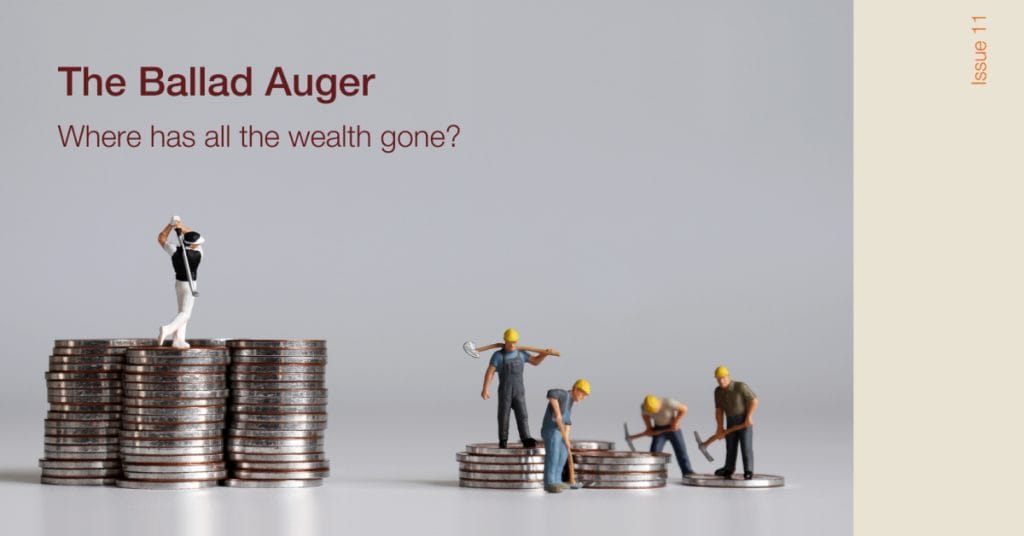
Canada’s economy faces an uncertain outlook as growth continues to slow, real estate markets are bottoming out, and distortions that accumulated during the pandemic are unwinding. These distortions include pent-up consumer demand and disrupted supply chains that are placing upward pressure on prices, with the Bank of Canada (BoC) raising its policy rate to 4.5% in response, an increase of 425 basis points from early 2022.[1] Unexpectedly high inflation was arguably the main macroeconomic theme of 2022, and the BoC’s success in tackling price growth will be a key determinant of Alberta’s economic performance in the coming period. The macroeconomic picture outlined above places additional financial strain on Canadian households, especially those with high levels of debt or which have already encountered economic hardships during successive pandemic lockdowns. Many households do not appear well-placed to manage further stress, while it is increasingly apparent that these effects will not be felt evenly across the economy. For example, surveys from Statistics Canada find that 63% of households in the lowest income quintile were “very concerned about the impact of inflation on their ability to meet day-to-day expenses”, three times higher than those in the top quintile.[2] The purpose of this in-depth note is to examine trends in household behaviour that emerged during the pandemic, and how the post-pandemic macroeconomic environment – including inflation and corresponding monetary policy decisions – are having varying impacts across different income quintiles. It is our estimation that these distributional effects will play an important role in public policy at the federal and provincial level in the coming years. Income issues and trends in the past Numerous publications have covered income disparities across different segments of Canadian society, with most pointing to growing income and wealth inequalities over time. For example, the Conference Board of Canada estimates that the median real income (adjusted for inflation) rose from $45,800 to $48,300 (5.5%) between 1976 and 2009, while average real income grew at a faster pace (16.8%) from $51,100 to $59,700 during the same timeframe.[3] This difference between median and average real household income growth suggests that individuals in higher income groups have been experiencing stronger relative earnings growth, with the Conference Board of Canada further estimating that the gap between the richest group and the poorest group widened from $92,300 to $117,500 over the same period. Consistent with this finding, a separate 2010 study from the Canadian Centre for Policy Alternative estimates that the share of income held by the richest one percent of Canadians has almost doubled from under 8% in 1977 to around 14% in 2007.[4] Income inequalities can also be tracked using the Gini coefficient which ranges in value from 0 (indicating perfect equality) and 1 (perfect inequality). Figure 1 sets out the Gini coefficient for Canada and Alberta, with the top two lines representing adjusted market income and showing that this has stayed relatively constant since 2000. Overall, the rise in market income inequality since the late 1970s stems from two main sources: 1) globalization and intensifying trade relationships has given a wage premium to workers with specialized skills in technology-intensive sectors, while at the same time lowering demand for labour in sectors that have been displaced by cheaper imports;[5] and 2) institutional forces such as declining unionization rates and stagnating minimum wages in some provinces have weighed on lower income groups more generally, while falling marginal income tax rates have been positive for higher earners. The adjusted after-tax index (bottom two lines) also accounts for government transfers and marginal tax rates across income groups.[6] This measure of income is thus broader as it includes additional sources of non-market income; it is apparent that Canada’s progressive system of taxes and transfers successfully reduces some of these income gaps. In particular, from 2015 to 2019, the after-tax income coefficient decreased to its lowest level since 1989 despite little notable change in the market income coefficient over the same period. Covid effects on household disposable income Beyond its public health consequences, the COVID-19 pandemic was a major shock to Canada’s economy, entailing widespread job losses, businesses closures, and reduced household spending, especially on services. In 2020, there were 113,835 fewer individuals across Canada receiving employment income than in the previous year, with household labour income falling by an average of $1,600 (Bank of Canada, 2021). These labour income losses were especially pronounced for low-wage workers, with the number of positions earning less than $16 an hour falling by 27% in 2020. Furthermore, there were significantly fewer individuals earning employment income of $20,000-$49,999 in 2020 (5.7 million) compared to in 2019 (6.4 million). The province experienced similar trends, with 60,000 fewer Albertans earning $20,000-$49,999 in employment income in 2020 compared to the prior year (Figure 2).[7] Despite these labour income declines during the early stages of the pandemic, emergency government transfers (e.g., CERB) were rolled out rapidly to labour market participants and business owners received support in the form of loans and subsidies. Between federal and provincial COVID-19 benefits, the average Canadian received $3,400, boosting her disposable income by $1,800 even as employment income fell.[8],[9] In fact, the bottom 20% of earners actually experienced a temporary rise in income as benefits exceeded pre-pandemic earnings (Bank of Canada, 2020). This trend is evident in Figure 1 as the Gini coefficient based on market incomes spikes upwards in 2020, whereas it turns downward based on after-tax incomes which includes social transfers and benefit payments. The combination of higher government transfers and changes in consumer spending habits during the pandemic resulted in a $5,800 increase in average per capita savings in 2020 (Bank of Canada, 2022), resulting in a record-high savings rate and the value of personal deposits in banks increasing by $150 billion.[10] However, research by the Bank of Canada reveals that savings among different income quintiles was not equal: 37.2% of extra savings was acquired by the highest income quintile, whereas the corresponding figure for the lowest income quintile was just 9.2%. Post-pandemic setting and policy pressures Many of the savings trends from the
Alberta navigates a narrow course towards fiscal sustainability
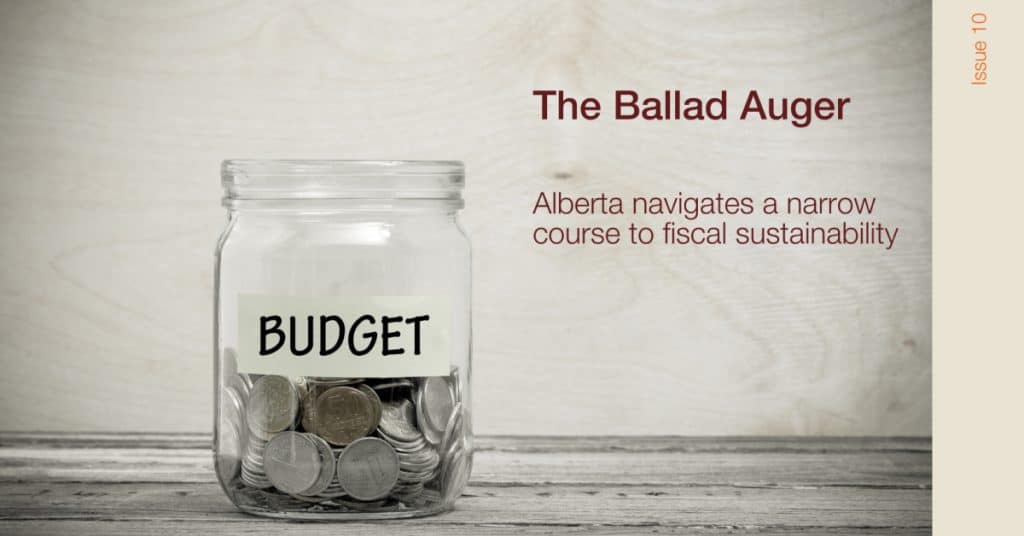
On the surface at least, much of the tone surrounding the Government of Alberta’s latest budget – released on February 28th – has focused on the additional funding promised to several parts of Alberta’s public service. Indeed, there are significant up-front increases in operating expenses for healthcare (4.1% in fiscal year 2023-24) and social services (8.8%), both of which are front-of-mind for voters as we approach the upcoming election: the challenges facing healthcare delivery include excessive emergency department and surgical wait times; while a year of high inflation and volatile energy prices have prompted the Affordability Action Plan, comprised of direct payments to households, energy rebates, and fuel tax reliefs. However, labelling this budget a “pre-election giveaway” is not quite accurate either, with much of the fiscal restraint shown throughout Treasury Board & Finance Minister Toews’ tenure remaining intact, both at the aggregate level and for individual programs. For example, even after accounting for increases in the areas highlighted above, total operating expenses are forecast to grow at an annual pace of 2.2% in nominal terms over the coming three years. Given successive years of high inflation and double-digit growth in nominal GDP, such expenditure growth does not appear excessive.[1],[2]Total provincial government spending – while increasing somewhat in the near term – will remain below 15% of GDP throughout the coming period (Figure 1), a level which remains markedly lower than other parts of Canada.[3] On the revenue side, higher energy prices and several major projects transitioning into their “post-payout” phase in 2022 resulted in windfall resource revenues, coming in at over $27bn and accounting for over one-third of all revenues in the last fiscal year. Here, too, some commentators have criticized the limited progress made in reducing Alberta’s overreliance on this highly volatile source of income. But, with the provincial government using last year’s surplus to pay down over $13bn of maturing debt and committing to a new fiscal framework, the charges of profligacy appear overdone. Going forward, oil prices are forecast to moderate towards a conservative level of $73-79 per barrel in the coming years, with this having a corresponding negative impact on resource revenues; whereas growth in underlying tax revenues (e.g., personal income tax, corporate income tax) is forecast to remain solid. To be sure, making progress towards reining-in the non-resource deficit and thus reducing debt levels or making larger contributions to the Alberta Heritage Savings Trust Fund is a laudable policy goal, especially during a period when economic growth will remain solid compared to the rest of Canada. In fact, some of the budget’s most interesting reading stems from the assumptions underpinning the economic forecast for the next three years. Whereas real GDP growth across the rest of Canada is expected to be anaemic at less than 1% in the near term, Alberta is set to see its economy grow by around 3% annually.[4] Stronger growth in Alberta is also forecast to encourage inter-provincial mobility, prompting a rebound in population growth to around 3% this year and alleviating some of the labour shortages that have become pronounced in sectors such as construction, accommodation and food services, and healthcare.[5] Against this broadly benign backdrop for economic activity and the labour market, the question becomes whether adding stimulus through higher spending is an appropriate policy stance. Again, it is a matter of scale: even with energy prices forecast to decline, the province expects modest budget surpluses in the coming years, albeit falling from $2.4bn (0.5% of GDP) in fiscal year 2023-24 to $1.4bn by fiscal year 2025-26. By contrast, had the provincial government chosen to stick with its spending plans as set out in last year’s budget, these annual surpluses would have been higher by over $7bn on average (1.5% of GDP), a considerable amount. The use of this fiscal space has been allocated to supporting municipalities which have grappled with weak economic growth and falling property assessments (especially for oil and gas-related properties); helping unemployed Albertans return to work through the Alberta at Work initiative; expanding the provision of healthcare; and allowing for wage increases for public servants, healthcare staff, and teachers. On the capital side, meanwhile, there are large upfront spending increases in areas like municipal transport – albeit mostly for the Edmonton and Calgary transit systems – healthcare infrastructure, and highway upgrades. After rising by almost one-quarter to reach $8bn this fiscal year, capital spending is forecast to moderate towards $7bn thereafter, reflecting the transition to the Local Government Fiscal Framework (LGFF) and reduced capital spending across a range of other policy areas. Analyzing budgetary numbers while abstracting from the actual programs that they are funding overlooks some important factors. The challenges facing many parts of the public sector in recent years have led to considerable shortfalls in policy delivery: post-secondaries are balancing reduced funding with rising demands, prompting hikes in tuition fees and excluding society’s marginalized cohorts in the process;[6] public safety concerns are heightened across the province, particularly in urban centres; while rural municipalities have had to contend with repeated cuts to infrastructure budgets, all while grappling with their own host of social issues. According to our estimates, operating expenses have increased by only 1% in real terms since this government assumed office in 2019, despite these additional demands on public services. Furthermore, the current forecasts actually anticipate a renewed decline in both operating and capital expenses in real terms over the coming three fiscal years.[7] Last week’s budget, then, represents a fairly modest reversal of earlier trends, and our overall interpretation is that a balance has been struck between meeting near-term spending pressures and preserving longer-term sustainability. While there are no guarantees that the spending restraint outlined for future years will be maintained, the introduction of a new fiscal framework further underlines the equanimity with which the province’s finances are being approached, and the determination to keep debt levels in check (Figure 3). This new framework: limits the growth in operations spending to population growth plus inflation; contains the scope for in-year spending increases to the amounts appropriated for
When will things start to break?

An often-used adage over the past year – albeit mostly in reference to the US Federal Reserve – is that central banks will “raise interest rates until something breaks”. There are signs that we may be reaching that point as sentiment across several advanced economy central banks seems to have shifted in recent weeks, beginning first with the Bank of England’s intervention in the UK gilts market;[1] while the European Central Bank (ECB) appears to be giving more weight to recession risks and widening bond spreads; and the Bank of Canada (BoC), despite noting that the economy is operating with excess demand and experiencing sharp price rises, decided to slow the pace of rate hikes to 50 basis points at its most recent meeting. The BoC’s latest increase brings the policy rate in Canada to 4.25%, with officials now highlighting the risks of over-tightening even as real rates remain steeply negative.[2] According to orthodoxy, one would expect the BoC’s shift to have been prompted by either: 1) progress in bringing down inflation and inflation expectations; or 2) signs that economic activity is slowing towards levels that are more in line with fundamentals, thus prompting a moderation in inflation going forward. Concerning the former, there is little evidence that inflation has slowed significantly: headline inflation came in at 6.9% y-o-y in October, only 1 percentage point lower than the peak reached over the summer. Furthermore, much of the recent progress reflects weaker commodity prices, whereas ‘stickier’ inflation components continue to grow. Indeed, core inflation has remained above 5% y-o-y in recent months and shows few signs of moderating quickly. No progress has been made in reining-in inflation expectations either, with three-quarters of firms expecting CPI to remain above 3% over the next two years (Figure 1). In terms of the BoC using monetary policy to slow growth and rebalance supply and demand, estimates of Canada’s output gap remain positive at between 0.25% and 1.25%, suggesting that tighter monetary policy and further slowdown is needed.[3] Nonetheless, while progress in the aggregate appears limited, there are initial signs that rising interest rates are beginning to slow the economy, with analysts increasingly anticipating a mild recession in 2023. Slowing economic activity is especially noticeable in areas that are more sensitive to interest rates: in the construction sector, for example, economic activity has contracted in the past 5 consecutive months as rising mortgage rates reduce the demand for homes, especially in overvalued locations; while related activities (e.g., mortgage origination) are likely to have also fallen in tandem.[4] In view of inflation remaining markedly above-target, the BoC’s shift in rhetoric has confounded financial markets’ earlier expectations for continued aggressive rate hikes going forward, with focus now shifting towards the ‘terminal rate’ that will be reached during this tightening cycle. In sum, financial markets’ focus has shifted from the ‘journey’ (i.e., the pace of rate increases) to the ‘destination’ (i.e., the level that rates will ultimately reach). Currently, financial markets expect interest rates to peak at around 4.75% in Canada in early 2023, before declining very gradually thereafter (Figure 2). These projections are subject to change given that they are based on financial market perceptions. Nonetheless, they indicate that an end of the BoC’s tightening cycle hikes is coming into view. The key question at this stage is, ‘Will a policy rate of 4.75% will be enough to quell inflationary pressures and sustainably bring core CPI down to the BoC’s 2% target?’.[5] The BoC clearly expects that this is the case, noting that it takes time for the effects of higher interest rates to fully disperse throughout the economy.[6] It appears, then, that we have entered a wait-and-see period as the BoC’s searches for answers to this question. At Ballad, our response is skeptical given that we see significant risks surrounding a more moderate approach to monetary policy, principal among which is a de-anchoring of inflation expectations across consumers and businesses. Although longer-term expectations remain stable for now, consumers’ short- and medium-term inflation expectations have already risen sharply (Figure 3). A new round of inflationary pressures – caused by, for example, a re-acceleration in energy prices – would likely cause a reassessment of these longer-term expectations, as well as prompting more widespread demands from workers for multi-year pay increases to cope with cost-of-living increases. The emergence of such a wage-price spiral would make the BoC’s task of reining-in inflation even more difficult.[7] Given the macroeconomic backdrop and the considerable risks of prematurely slowing the pace of interest rate hikes, it is reasonable to ask why the BoC has seemingly changed course. One possible answer lies in the vulnerabilities and fragilities present in the Canadian economy, including its limited capacity to tolerate higher interest rates from here. As noted earlier, signs of slowing economic activity are much more evident in interest-rate sensitive sectors such as construction and related financial services. Essentially, households that are already heavily levered are unable to take on more debts for new home purchases or other big- ticket items, especially as interest rates continue to rise. The amount of credit extended to Canadian households reached a new peak of $2.7 trillion in the first quarter of 2022, equal to 106% of Canada’s annual GDP and spurring a housing market boom in which prices have more than tripled since the 2008 financial crisis. Indeed, whereas many other advanced economies saw reductions in household debt following the crisis, the Canadian household sector has accumulated debt rapidly to become one of the most highly leveraged in the world.[8] What does this debt build-up mean in a new paradigm in which interest rates are no longer zero? Firstly, we split the mortgage market into its component parts: 1) variable rate mortgages which see their interest rates fluctuate in line with BoC policy; and 2) fixed rate mortgages, often for a period of 5 years. New mortgage issuance has shifted towards variable rates in recent years, particularly as the interest rate spread to fixed rates widened and lenders offered discounts to attract new borrowers into
Squaring Long-Term Unemployment with Labour Shortages
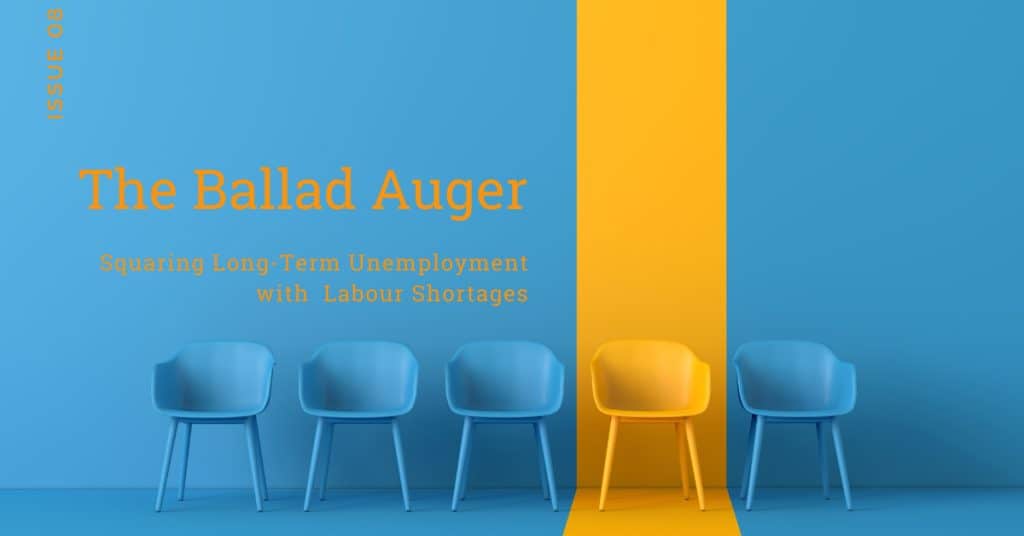
Alberta’s labour market is continuing its recovery, with the unemployment rate (6.5% in March 2022) falling below pre-pandemic levels and employment demand accelerating across several sectors.[1] The labour market has added a further 22,000 jobs so far in 2022, broadly shrugging off the effects of the Omicron variant and bringing total employment in the province to a new all-time high, while the numbers of people working from home are on a steady decline as business conditions normalize. The progress made at the aggregate level is remarkable, with the recovery’s pace and breadth surpassing most expectations and many of the pandemic’s distributional effects have by now been overcome.[2] Beneath the surface, however, there are several points of divergence across the labour market’s subgroups. Most notably, while employment has rebounded in sectors such as natural resources (e.g., oil and gas) or retail and wholesale trades, performance in others has been much weaker so far (Figure 1). These weaker sectors include accommodation and food services (-13% relative to pre-pandemic levels) and other services (-8%), both of which were exposed to public health restrictions that limited face-to-face interactions and severely weighed on demand, while the sharp decline in employment in the agriculture sector (-34%) reflects labour supply issues and travel restrictions on seasonal workers. The pandemic’s effects on labour supply more generally remain evident: the participation rate (69.3%) is 1-3 percentage points (pps.) lower than pre-pandemic levels, with the decline especially sharp (-6 pps.) among males aged over 55 years. There are specific issues restricting the participation of this labour market cohort: their health risks of contracting the virus are materially larger than younger workers;[3] while appreciating asset prices (real estate, financial) over the past two years has likely added to their wealth, in turn bringing forward retirement dates. This combination may have prematurely removed some workers from the labour market and risks turning the pandemic’s temporary negative shock into a much more persistent one, particularly as retirement decisions are often difficult to reverse. Such permanent changes in the labour market that result from temporary shocks are referred to as ‘hysteresis’.[4] In Alberta’s case, we are concerned that permanent changes following the pandemic may include: (i) lower participation rates among certain cohorts (as just illustrated); and (ii) the greater numbers in long-term unemployment and difficulties in reskilling and retraining this segment of the labour market. Concerning the former, the onset of early retirements raises questions as to whether new workers will be able provide an offset, both in terms of overall numbers and productivity levels. As for long-term unemployment, meanwhile, labour market data is already pointing to this challenge: the average number of weeks in unemployment currently sits at 26.8 (compared to 17.9 weeks pre-pandemic), while around one-third of all unemployed are long-term (Figure 2). With unemployment spells remaining elevated even in the context of a growing economy and strong labour market, there are worries that this cohort is getting left behind. As argued by the Business Council of Alberta (2021), extended periods of unemployment lead to declines in lifelong earnings, especially for older workers that are missing out on some of their highest years of earnings. Poloz and Wilkinson (1992) provide succinct summary of the forces behind hysteresis, which include: (i) deteriorating human capital as skills deteriorate with lengthening spells of unemployment or non-participation; (ii) insider-outsider models in which those who remain in employment prefer to keep real wages high rather than make room for the unemployed to return to work; and (iii) institutional models which show that regulations, entrenched behaviours, and rigidities reduce the labour market’s capacity to adjust to shocks. Concerns over hysteresis in the labour market are amplified by widespread vacancies that are going unfilled. The total number of job vacancies was at record highs of 86,000 across the province during 2021-Q4, corresponding with a vacancy rate of 4.3% (Figure 3). The region of Banff-Jasper-Rocky Mountain House and Athabasca-Grande Prairie-Peace River appears to have an especially high vacancy rate of 5.7%, reflecting differences in the composition of its local economy and higher exposure to in-demand sectors. Data at the national level shows that accommodation and food services (9.8%), construction (6.0%), healthcare and social assistance, and other services (5.8%) have the highest vacancy rates, and these challenges are likely to be even more acute in rural areas where the pool of available labour is smaller. This data is corroborated by employer surveys, many of which concur on staffing shortages and barriers to finding appropriate employees. For example, Alberta Chambers of Commerce and the Business Council of Alberta (July 2021) found that a lack of applicants, lack of skills, and competition from other employers were the main barriers to hiring, with this already starting to affect output and limiting capacity to grow. The data also seem to suggest bifurcation into: (i) lower skilled positions for which it is relatively easy to find workers; and (ii) higher skilled positions requiring a university education or trade certificates, with the pool of suitable applicants for these roles much more limited. This bifurcation adds to our concerns over the labour market’s near-term capacity to replace retiring workers with greater experience, skillsets, and productivity. Similarly, recent reports from the Canadian Federation of Independent Business (CFIB) show that almost half (46%) of Albertan small businesses are experiencing staff shortages, with one-quarter (24%) estimating that current shortages are affecting business operations; while Business Development Bank of Canada (BDC) found that many small- and medium-sized businesses must leave their vacancies open for several months. These surveys point to another source of reduced labour supply: many workers in industries most affected by the pandemic (e.g., personal services, hospitality) have left in search of more stable employment elsewhere and incentives to return are limited. BDC research finds that 20% of those who became unemployed during the pandemic switched sectors, while CFIB found that this percentage is even higher among people who were laid off from the hospitality sector (48%). Concerningly for employers in the industry, research from Statistics Canada (2018) found that job quality
Alberta’s Place in a Fragmenting Global Economy

The conflict in Ukraine is generating significant consequences for the global economy: in the short term, commodity prices have moved sharply higher due to renewed supply chain disruptions and lost output in a key region; while in the long term, Russia’s unilateral actions and coordinated Western sanctions appear to indicate further fragmentation along geopolitical lines. At this stage, the emerging economic landscape encompasses the United States and its liberal democratic partners on one side, opposed by China and its key trading counterparts (including Russia) on the other. The West’s response to Russian aggression so far has included a phasing out of energy imports, excluding Russian banks from the internal payments architecture (SWIFT), and freezing the central bank’s foreign currency reserves; while a host of private companies have voluntarily withdrawn from the Russian market and several prominent oligarchs have had their assets frozen. The breadth and scale of these measures are significant and underline a fundamental re-evaluation of the West’s relationship with one of the world’s largest economies and a key producer of commodities in energy, metals, and agriculture.[1] The immediate impact on global markets has been a sharp upward movement in the prices of those commodities (Figure 1), stemming from: (i) the physical impact of the war on Ukrainian transport infrastructure; and (ii) the direct impact of sanctions which limit the supply of Russian goods. Furthermore, the conflict has raised transport and insurance costs for producers across the wider region. This combination has placed renewed upward pressure on headline inflation; the price growth impetus that initially came from the pandemic has rotated to the Ukraine conflict and its geopolitical consequences, aggravated further by droughts and unfavourable weather for crops. This in turn is generating greater urgency across central banks to raise interest rates, while policymakers also rushed to release fuel reserves (e.g., the Strategic Petroleum Reserve), remove certain consumption taxes, and once again shore up supply chains for key industrial and agricultural inputs. With crude oil above $100 per barrel and natural gas prices at their highest level since 2008, producers can reconsider the viability of previously shelved projects. While there are policy uncertainties surrounding the transition to net zero emissions, Europe’s urgent need for LNG to replace current Russian imports presents Alberta with an opportunity to develop a new market with growing demand.[3] Such market opportunities, combined with the province’s broader strategies for natural gas and hydrogen production, provide a route towards shifting the energy sector higher up the value chain while remaining competitive. Producing cleaner, high value-added products will remain an imperative policy goal, particularly given that previous oil price shocks have led to permanent demand destruction as consumers reduce consumption, improvements in energy efficiency are found, and new sources of energy are developed (e.g., renewables, fracking technologies). Indeed, a significant part of the European response to phasing-out its energy imports from Russia is a doubling down on support for renewables and bringing forward its climate change commitments. In Ballad’s view, Europe’s changes to the composition of its trading partners – particularly in its procurement of natural resources – underlines a deeper geopolitical and economic shift taking place, wherein earlier globalization trends are reversing, and trade relationships are being reconfigured on a more regional basis. The repudiation of free trade and capital flows has been building for several years; events such as Brexit, the US-China trade tensions, or the supply chain disruptions caused by the pandemic have all coincided with growing anti-globalization sentiment and calls for re-shoring of production. However, the conflict in Ukraine and the West’s response is one of its most significant manifestations: unprecedented measures such as freezing the Russian central bank’s dollar-denominated assets and committing to reduced Russian energy dependence represent a departure from earlier approaches, while also seeming to illustrate the West’s acquiescence to geopolitical realities. As noted by Tchakarova (2022), the emerging geopolitical and economic landscape is characterized by: (i) a bifurcation of the global economic and financial system which will include systemic competition between the US and China; and (ii) fluid geopolitical constellations between more regional powers. The early stages of these shifts are already playing out, with the US and UK beginning discussions on Transatlantic trade, while the US’s new procurement guidance requires that infrastructure projects be built with domestic materials.[4] Fragmentation of the global economy along these lines would slow the exchange of technologies and productivity improvements, with reports already emerging that some multinational corporations are shifting their supply chains closer to key markets. The medium- and long-term consequences of this shift are significant. Several organizations have published estimates of lower global GDP and global trade as a result of sanctions, as well as significant adjustments for industries and labour markets within countries.[5] In theoretical terms, the reason for lower output stems from efficiency losses as countries are no longer producing goods according to their comparative advantage; the pursuit of more autarkic and nationalist economic policies means that labour and capital are not being deployed in their most productive uses.[6] In a world with conflict and geopolitical competition, energy and food security concerns are likely to trump the efficiency and welfare losses that can be anticipated. Even in the absence of conflict, however, the ongoing supply chain disruptions highlight the fragility of pre-pandemic supply chains. It is difficult to identify in exact terms what these global shifts imply for Alberta. After all, whereas global economic output is unequivocally expected to fall, the specific effects on Alberta’s economy are more ambiguous. For example, higher prices for producers due to less international competition would raise output in those sectors, whereas the loss of access to a large market (e.g., China) would imply losses for those businesses that are most exposed.[7] An overwhelming majority (89%) of Alberta’s merchandise exports go to the US as their first destination, implying that the province’s exposure to other regions is limited. It is clear, then, where Alberta’s economic interests lie on this divide. Calls for Alberta’s economic diversification grow louder with each downturn in commodity prices. Often, however, what is
With anchors set, what’s next for fiscal policy in Alberta?

On February 24th, Travis Toews set out his Ministry’s views on the provincial government’s fiscal position, presenting an upbeat assessment that few would have thought credible just a short time ago. In particular, a combination of higher royalties from natural resources, rising tax receipts as the economy reopens, and declining pandemic-related spending will see the province deliver a modest budget surplus ($511m) in the next fiscal year, its first in almost a decade. This fortuitous turn of events – particularly the return of oil prices above $100 per barrel in recent weeks – ensures that the fiscal anchors set by the provincial government have by now been achieved.[1] After swelling to $17bn in fiscal year 2020-21, the budget deficit will fall to just $3.2bn in 2021-22 and will be eliminated entirely thereafter. The province is forecasting modest surpluses of between $500 and $900m (or 0.1%–0.2% of GDP), with these currently allocated to restoring the Heritage Savings Trust Fund or paying down debts. In turn, budget surpluses will limit the accumulation of taxpayer-supported debt which is now forecast to stabilize at just under $100bn, while net debt-to-GDP is projected to fall gradually towards 15% over the coming three-year period. A significant portion of the turnaround in provincial finances is attributable to natural resource revenues coming in much higher than previously expected. This increase has been driven by rising global demand as the pandemic subsides; low inventories and supply constraints after years of declining investment in the energy sector; and the current conflict in Ukraine and corresponding sanctions on Russia, one of the top crude oil producers globally. This tailwind has opened some fiscal space for spending on critical priorities in the near term, while the province’s prudent estimates for oil prices going forward provides an opportunity for revenues to surprise on the upside in future years. This brings us to a crucial question that the budget poses: what new anchors should be put in place to ensure that Alberta’s finances remain sustainable going forward? After all, much of the revenue gains have been driven by higher oil and gas prices, pointing to a budgetary process that is still highly volatile and exposed to shifting commodities prices. An appropriate fiscal framework going forward must be one that limits pro-cyclical behaviour when oil prices are high, as well as building up reserves to offset future downturns. This will require a fundamental rethink of how resource revenues are managed going forward, as well as continued discussion on whether higher taxes are needed elsewhere. At the aggregate level at least, it appears that some progress will be made in insulating the budget from oil price fluctuations. The budget balance when resource revenues are excluded is forecast to fall from over $20bn in 2020-21 to just over $10bn by 2024-25 (Figure 1). Much of this improvement is driven by robust growth in personal and corporate income taxes, contributing around half of all growth in non-resource revenues over the period (Figure 2).[2] Overall, provincial government revenues are forecast to rise to just under $64bn in the coming years, with modest declines in resource revenues from their current highs offset by gains elsewhere. It should be noted that overall provincial tax burden in Alberta remains small, especially when compared with other provinces or competing locations for investment.[3] This feature of our economy is often pointed to as a cornerstone of the ‘Alberta Advantage’. However, spending pressures will continue to rise in the coming years (e.g., healthcare) and the province’s central role in providing critical infrastructure will need to be fulfilled. On the spending side, the improved fiscal and economic outlook has provided the government with room to increase spending in critical areas such as health, education, and labour market development. Excluding pandemic-related spending and one-offs, operating expenditure is forecast to rise from $49bn in the current fiscal year to almost $52bn by 2024-25 – an average annual increase of around 2% – while total government spending is set to rise from $61bn to $63bn over the same period. However, these numbers sound less impressive when considered against a backdrop of inflation running at 5% across Canada. In real terms, both revenues and spending will fall over the coming years (Figure 3). As such, for those worried about government largesse, this budget is by no means a giveaway; government ministries and agencies must continue looking for efficiencies in how they deliver their services. The need for maximizing spending efficiency is especially pronounced at the Ministry of Labour and Immigration which received an additional $600m over three years for implementing the Alberta at Work initiative. The provincial government’s renewed focus on the labour market is much needed given continued challenges and widespread evidence of skills mismatch. For example, while the unemployment rate – 7.2% in January 2022 – and the overall number of jobs have both recovered to their pre-pandemic levels, the participation rate remains lower and suggests that some cohorts have detached. This concern is amplified further by the increase in average length of time spent in unemployment, which now stands above 28 weeks (Figure 4). These people will face severe barriers in returning to employment in the absence of policy interventions such as reskilling and retraining. Labour market displacement prompted by the pandemic and successive years of weakness in the energy sector are especially visible across rural Alberta. Much of the funding announced, from building basic literacy skills to enhancing apprenticeship programs or additional seats in technology-related fields, will be instrumental in lowering unemployment across rural communities. These programs coincide with the province’s broader commitment to broadband infrastructure, additional healthcare personnel, and attracting skills to rural areas. Rural municipalities should already be considering how best to take advantage of these programs. In summary, the provincial government finds itself in an unquestionably more favourable position than just a year ago. It must be emphasized, however, that higher oil resource revenues are not providing Alberta with an indefinite get-out-of-jail-free card; with the exceptions of a few programs, most government ministries will have to closely monitor
Walking the Corporate Debt Tightrope

In our previous issue, we outlined some of the risks facing the outlook for inflation and the benign assessment that price pressures were ‘transitory’. In early 2022, with headline consumer prices rising at almost 5% annually and core inflation firmly above the Bank of Canada’s target range, the narrative surrounding monetary policy has shifted markedly, with most commentators now questioning how quickly a tightening cycle might proceed in the near-term. These dynamics have important implications for the nascent economic recovery underway in Alberta, as well as how the pandemic’s many economic legacies are to be addressed going forward. In our estimation, the principal risk at this stage is that high inflation becomes entrenched, prompting interest rates to rise sharply in order to re-anchor expectations. For 2021 as a whole, consumer prices rose by 4.8% year-on-year, driven by rising costs for energy, durable goods, and food; while price pressures have retained solid momentum as core inflation rose a further 0.4% month-on-month in December.[1] In addition to this momentum, many of the underlying factors pushing up prices that we highlighted previously (wage growth in some sectors, supply chain shortages, late stage of the economic cycle) remain in place, and inflation expectations have been rising in recent months. Central banks have already signalled their intention to raise interest rates in the near-term. Most notably for Canada given its close economic ties to the United States, the Federal Reserve’s most recent projections include a marked upward revision to its forecast for interest rates (Figure 1). While rates remained at historic lows at 0.25% in December 2021, the Federal Reserve is expecting 3 rate increases in 2022, bringing interest rates to 1% by year-end, followed by a further 3 rate hikes in 2023.[2] This projected pace of tightening is sharper than projections just three months previously, and points to growing concerns over falling behind the curve in taming inflation. At the same time, policy hawks are concerned about spillovers from loose monetary policy to asset prices and the buildup of imbalances in the financial sector. Concurrent with raising interest rates, the Federal Reserve will also likely consider unwinding its almost $9 trillion (US) balance sheet over the coming period. The Canadian and US economies are highly integrated, meaning that monetary policy stances often follow the same pattern.[3] Last week saw the Bank of Canada (BoC) release its latest monetary policy decision and accompanying Monetary Policy Report. While holding off on a rate rise for the moment, the BoC has already moved to start reining in some of its stimulus: purchases of additional federal government bonds under the Government of Canada Bond Purchase Program (GBPP) have ended, with the BoC shifting to a ‘reinvestment phase’. This has left the BoC holding some $430bn in federal government bonds (Figure 2), or almost half of all federal government bonds outstanding. Going forward, a benign economic environment would likely prompt the BoC to allow these bonds to mature gradually.[4] The value of federal government bonds held by the BoC has increased by 550% in the two years since the pandemic began and is estimated to have lowered yields on federal government bonds by an average of 10 basis points (Bank of Canada, 2021).[5] In response to the anticipated tightening of BoC policy – including via interest rate increases and the eventual unwinding of federal government bond holdings – asset prices have already started to adjust. Most notably, yields on long-term debt have risen to pre-pandemic levels and are likely to receive further upward impetus as the economy moves towards excess demand and supply constraints are already binding. Added to this, while many pandemic-related supports are being removed, the federal government will continue to run modest deficits over the coming years, coming in at -2.2% of GDP in FY 2022-23. This combination will put upward pressure on yields for federal government bonds, in tandem raising borrowing costs across other Canada-based debt instruments in financial markets. For example, yields on 10-year Canadian government bonds have more than tripled from 0.5% in mid-2020 – the most acute phase of the pandemic – to above 1.7% in recent weeks (Figure 3). In order not to sound overly alarmist, it is necessary to keep some of these numbers in perspective. Firstly, during ‘normal’ economic conditions, falling yields on government bonds are often interpreted as a sign of impending recession and limited opportunities for capital to flow into productive investments. The nadir reached in mid-2020 is a perfect illustration of how yields fall in response to uncertainties or pessimism over the economic outlook. As a corollary, therefore, rising yields can be interpreted as signs of rebounding economic activity. Secondly, while yields (i.e. borrowing costs) have risen, it is important to note that they remain very close to historical lows; we are likely to still be some way off the level at which government or corporate debts become unsustainable. Now, back to the pessimism. The reason why rising inflation and tightening monetary policy have become such a concern is due to elevated debt levels across Canada. It is not just household debt and the Canadian housing market that should capture our attention; Canadian businesses have been borrowing at an exceptional pace (Figure 4). In the past 10 years – a period characterized by loose monetary policy and a brief tightening cycle – total debt-based credit liabilities of non-financial corporations more than doubled to reach almost $1.8tn.[6],[7] Since the onset of the pandemic, meanwhile, Canadian businesses have added a further $175bn – an increase of 11% – to their debt levels, pushing non-financial corporate debt-to-GDP above 130%.[8] Furthermore, debt service ratios – which reflect the share of income used to service debt – have decoupled from other advanced economies and remained close 60% for a prolonged period. The onset of even a modest tightening cycle will at the very least curtail investment and economic growth, while potentially also creating solvency pressures on highly indebted Canadian businesses. Higher corporate debt levels have also resulted from the federal government’s response to the pandemic,
Calgary Supply Chain Sector Benefits from new Strategic Training Partnership

BALLAD GROUP AND CITT ANNOUNCE STRATEGIC PARTNERSHIP TO LAUNCH CAREERS IN SUPPLY CHAIN LOGISTICS CALGARY– Ballad Group has announced their newest formal partnership with CITT to design and deliver an innovative integrated training program that directly responds to industry needs in Calgary, Alberta. The Fundamentals of Supply Chain Logistics (FSCL) program will focus on preparing participants for meaningful employment in the rapidly changing supply chain sector. Over two years, 96 unemployed Albertans will have the opportunity to participate in a 12-week in-class training program and complete a 4-week work placement with one of Ballad’s industry partners. This unique learning experience ensures program participants are job-market ready. Graduates of Ballad’s Fundamentals of Supply Chain Logistics program earn the Canadian Transportation & Logistics Fundamentals MicroCredential and two credits (Logistics Processes and Transportation Systems) towards the CITT-Certified Logistics Professional (CCLP) designation. “CITT is very excited about partnering with Ballad in this new micro-credential. The opportunities to fuel job growth and nurture the logistics sector in Alberta are enormous; Ballad is well-positioned to deliver this credential in ways that make positive changes in Alberta communities and build industry. We look forward to working with Ballad to realize both of our organizational mandates.” -Pina Melchionna, President & CEO, CITT “A foundational component of our business model is strategic partnerships. We are thrilled to launch this partnership with CITT and expand Ballad’s service offerings in the Calgary region. Our FSCL training program will help many Albertans obtain employment in a growing sector of the labour market.” -John Corie, Managing Partner, Ballad Group The Province of Alberta is working in partnership with the Government of Canada to provide employment support programs and services that are free to qualifying participants. ABOUT CITT CITT is industry’s most valued and respected source of complete, career-long learning and career-path development open for everyone who buys, sells, or manages the flow of goods and product, or is impacted by supply chain logistics. CITT provides: Professional certification in logistics (the CCLP designation) – www.citt.ca/cclp Logistics and business management courses – www.citt.ca/courses Industry’s top-rated annual Canada Logistics Conference – www.citt.ca/conference SCL Webinar Series – www.citt.ca/webinars Professional SCL Talent Pool —www.citt.ca/talentpool CITT learning and professional development offerings are all affordable, accessible online and have the best ROI in the business. Visit the CITT website at www.citt.ca for more information. CCLP® is a registered trademark of CITT. ABOUT BALLAD At Ballad Group, we work with learners, businesses, rural municipalities, and Indigenous rights holders to achieve their goals, seize opportunities, and create a positive impact. Through our training and consulting services, we combine our experience, knowledge, and strong relationships to empower people, solve challenges, and foster sustainable outcomes.
Returning Inflation Starts to Complicate Policy Responses
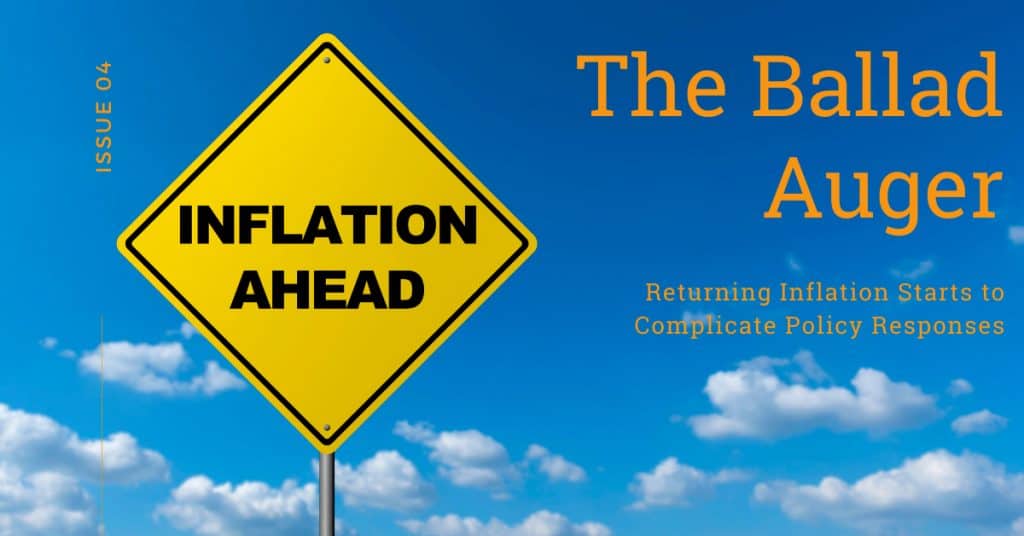
Strong uptake of vaccines across the province has prompted the swift removal of most public health restrictions. While uncertainties and risks regarding new variants remain, this recent progress is generating optimism that we may be approaching a definitive endpoint to the COVID-19 pandemic and its severe consequences. In economic terms, these consequences have included a sharp slowdown in economic activity, widespread disruption in the labour market, and elevated public sector deficits, among others. Although recovery across each of these areas still has significant room to run, it is a welcome development that narratives have shifted towards addressing the pandemic’s legacies and orienting Alberta’s economy towards future areas of growth. The appearance of more routine economic conditions on the horizon is accompanied by debates on how economic policy can successfully manage the transition into a post-pandemic environment. There are questions on how to prudently unwind the demand-side supports given to businesses and households without stifling the recovery underway, balanced on the other hand with concerns over the distortions, imbalances, and inefficiencies they have created. Some of these adjustments are already taking place: at the provincial level, fiscal policy is shifting its focus towards deficit reduction and reigning in public spending, while other arms of government are tackling competitiveness and productivity issues on the supply-side. Monetary policy had been receiving less attention by comparison – until recently, that is. The release of June’s Consumer Price Inflation (CPI) figures points to the emergence of price pressures in some key areas. Headline CPI came in at 3.1% year-on-year (y-o-y), completing a hattrick of recent inflation releases above 3% (Figure 1). This is marginally above the Bank of Canada’s inflation target and has put a renewed spotlight on when interest rates might begin to rise. It is important to note that much of the recent increase in the CPI relates to: (i) statistical base effects from 2020 in which economic activity and prices were exceptionally low due to global lockdowns; and (ii) surging energy prices which were 19.5% y-o-y higher in June. When looking at core inflation – which excludes volatile items such as food and energy prices – price pressures were much more muted at 2.2% y-o-y.[1] That is not to say that recent inflation dynamics are unimportant; just that they are unlikely to trigger significant concern among policymakers in the near term. Nonetheless, there are a number of interesting features from the inflation data to note. Firstly, the emergence of price pressures at this very early stage in the recovery is surprising: core inflation, at 2.2% y-o-y, has risen markedly (up from less than 1% earlier in the year) even though unemployment remains high and there is widespread evidence of slack in the economy. For example, Bank of Canada (BoC) estimates that the output gap is currently at between -3% and -2%, while its composite measure of labour market performance remains weaker than the pre-pandemic period; the economy remains some distance from the point at which we would expect inflation to appear.[2],[3] Secondly, wage pressures play a key role in driving inflation and inflation expectations. Counterintuitively, average wages across Canada actually rose sharply during the early stages of the pandemic as a disproportionate number of lower-income workers were laid off. These dynamics continue to distort the data as many of these workers have by now returned, but employer surveys point to rising employment and higher wage demands in the near term. Employee demands for higher wages seem anomalous given still-high unemployment and the broader uncertainties surrounding the labour market’s recovery. There are several reasons for this: (i) experienced staff in some sectors (especially retail and accommodation and food services) have sought work in other, more resilient sectors, reducing labour supply;[4] (ii) more generous income supports (e.g., Employment Insurance, Canada Recovery Benefit) may have contributed to rising reservation wages in some sectors, particularly lower-paying ones;[5] (iii) there have been changes in workers’ needs, with staff demanding more flexibility in terms of hours and remote working; and (iv) structural changes such as automation or technologies have placed an even greater premium on skills. In the context of Alberta’s unemployment rate of 8.5% and employment remaining 1% below pre-pandemic levels, this points to potential signs of mismatch in the labour market and a period of adjustment to come (Figure 2). In June, for example, job postings rose by over 30,000 – well above historical averages – even as full-time positions decreased by 37,000. Our initial estimation at Ballad is that some workers displaced by the pandemic may not have the requisite skillset to immediately transition into growing sectors, making a higher structural unemployment rate a likely feature of recovery. This requires some thought among policymakers and business owners regarding skills needs and how labour supply can best meet these. In the meantime, higher wage pressures may be something that employers have to tolerate, in turn passing some of these costs on to consumers. Finally, upward price pressures also stem from supply chain disruption and production bottlenecks. The price of durable goods increased by 3.9% y-o-y in July (up from 1.4% in 2020), while survey indicators point to continued rises in input and output prices across manufacturers. This data corroborates Ballad’s own engagement with Albertan businesses which identified severe supply chain issues, including difficulties in securing raw materials, intermediate, and final goods; lengthy delays in having orders refilled from suppliers; as well as higher shipping costs and difficulties in securing freight services. Most businesses that we’ve spoken with expect these supply chain issues to persist into at least 2022 as economic recovery progresses and businesses catch up on delayed investments and capital spending.[6] Given the severity of supply chain challenges and their importance for both businesses’ and public sector capital spending plans, we will be taking a deeper dive into supply chain dynamics in the post-pandemic economy as part of our forthcoming issues. Entire industries are in the process of reorganizing their supply chains and it will be essential for Alberta’s business community and its advocates at all levels
About Those Property Taxes…
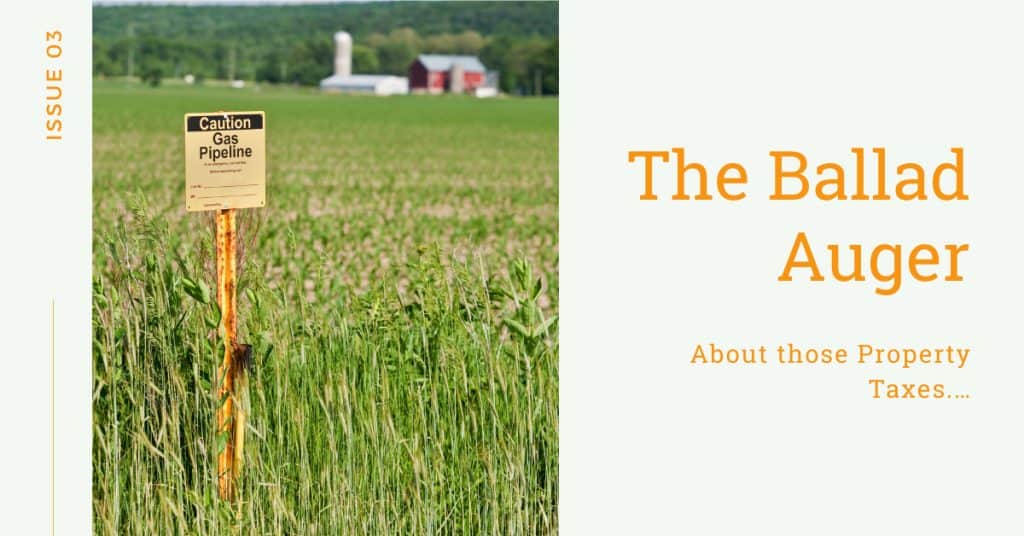
Following on from our last issue in which we highlighted the funding pressures facing Alberta’s municipalities due to reductions in provincial government transfers, today we take a closer look at another area of fiscal concern: the accumulation of property tax arrears among oil and gas companies across rural Alberta, and the crossroads that have been reached in balancing industry competitiveness with community viability. Municipalities across the province – particularly those with smaller property tax bases – are already encountering challenges as infrastructure demands continue to rise, cost obligations for some services (e.g., policing) are increasing, and the forthcoming shift to the Local Government Fiscal Framework is expected to entail lower baseline levels of provincial funding. Municipalities’ capacity to raise their own revenues, meanwhile, has also come under pressure as successive years of weak growth has reduced assessment values for residential and commercial properties, while their ability to raise revenues via other means (e.g., sales taxes, user fees) is limited.[1] Given these dynamics, non-payment of property taxes presents a significant challenge to the fiscal sustainability of many rural municipalities and reignites concerns regarding longer-term viability. Some companies in the oil and gas industry have been accused of ignoring their property tax obligations, leaving the municipalities in which they operate in a precarious position.[2] The most recent (March 2021) member survey by Rural Municipalities of Alberta (RMA) puts the figure of outstanding property taxes at just under $250m, with this bill more than tripling in the past two years (Figure 1). The average amount owing to a municipality is $3.5m, while five municipalities have unpaid taxes of over $10m. The fact that over half (57%) of these taxes are owed by companies that continue to operate has introduced an unfamiliar layer of tension into a previously symbiotic relationship.[3] In response, Alberta’s municipalities have noted that tax rates for other property types will have to rise in order to offset these losses, or essential services will have to be cut further as legislation prevents them from running deficit budgets. The challenge for municipalities is complicated by legal provisions which prevent them from applying tax recovery tools (e.g., asset sales) that are ordinarily applied to residential and commercial properties. This is because oil and gas companies often only lease a portion of the land on which they operate a well or pipeline, meaning that it would be unaffected by a tax recovery tool on the property itself; while oil and gas-related equipment and assets can be quickly moved to other sites when needed. In the case of bankrupt companies, meanwhile, legal decisions (e.g., Redwater) have prioritized environmental concerns over debt repayment, with proceeds from asset sales to be set aside for well cleanup.[4] Again, this leaves municipalities that are owed property taxes at the back of the queue as they are considered unsecured creditors. Both the provincial government and industry have welcomed these decisions due to the mounting costs of well cleanup and fears that these would fall on remaining industry members. Figure 2 sets out the number of orphan wells in Alberta and their rapid increase in recent years as energy companies have gone bankrupt. In principle, the cleanup costs are to be covered by the companies themselves, and, in the case of bankruptcies, by the industry-funded Orphan Well Association (OWA). However, the provincial government has already provided hundreds of millions in grants and loan funding to accelerate the process of well decommissioning and reclamation, with the federal government also launching a $1.7bn fund in 2020.[5] To higher levels of government, then, the municipalities’ concerns over property tax arrears must be weighed against these environmental risks, as well as the broader intention to maintain industry competitiveness and employment levels. Industry responses to the issue have stated that: (i) the scale of the problem is small relative to the number of operators who continue to pay their taxes without delay; and (ii) high property taxes are adding to operating costs in an industry that has already been struggling for a number of years. This latter point is particularly interesting as, despite the economic challenges facing Alberta in recent years, property tax receipts for Alberta’s municipalities (excluding cities) have actually increased.[6] More concretely, even though real GDP in Alberta was still around 1% lower in 2019 than in 2014, municipal property tax revenues (excluding cities) were over 10% higher (Figure 3). These figures are not broken down further into property taxes relating to oil and gas specifically. However, Figure 4 illustrates the trend in both linear assessment values – i.e. types of property which include wells and pipelines – and crude oil prices in recent years.[7] Linear assessment values have indeed fallen from earlier levels, coming in around 4% lower in 2019 than in 2014. However, oil prices fell by around 40% over the same period.[8] These challenges have become even more acute in the context of the COVID-19 pandemic and its economic spillovers, including for the energy sector. At the very least, this points to a problematic disconnect between the revenues that oil and gas companies are able to earn from the properties on which they operate, and the taxes they must pay for the privilege to do so. Unlike activity in most other sectors which is, broadly speaking, indifferent to where the business owner decides to operate, oil and gas companies are restricted to locations based on resource availability. This is compounded by the fact that well production decreases over time, with industry stating that much of the arrears issue relates to older properties which are no longer economically productive. These wells are not able to cover their operating costs, much less pay for property taxes. In view of the environmental concerns outlined earlier, it is reasonable to argue that remaining revenues should be used to pay for cleanup costs. The industry viewpoint has garnered sympathy with the provincial government which has consistently argued that the best route towards having oil and gas operators pay their property taxes is through getting the industry back on its feet. This approach has entailed
